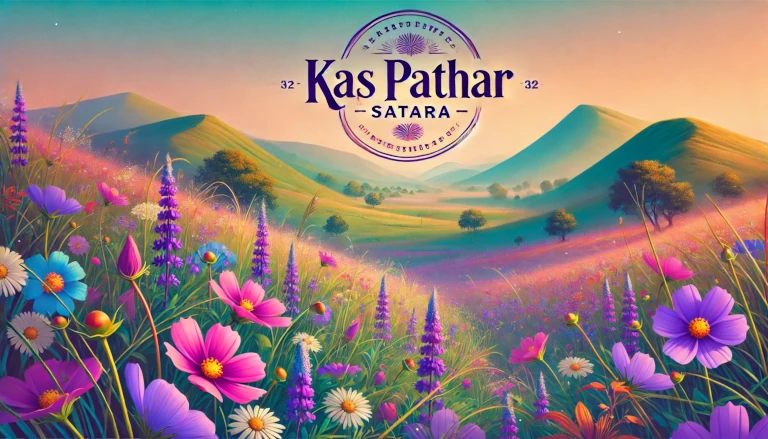Kas Pathar, also known as the Kaas Plateau, is a breathtaking biodiversity hotspot located in the Western Ghats of Maharashtra, India. Renowned for its seasonal bloom of wildflowers, this UNESCO World Natural Heritage site is a stunning destination for nature lovers, botanists, and photographers alike. Every year, from August to October, the plateau is covered with a carpet of colorful flowers, creating a mesmerizing view and attracting visitors from across the globe.
In this blog post, we’ll explore what makes Kas Pathar so special, its flora and fauna, how to plan a visit, and why it’s a must-see destination for anyone interested in nature and conservation.
What is Kas Pathar? 🌿🌼
Kas Pathar is a highland plateau situated at an altitude of approximately 1,200 meters above sea level in the Satara district of Maharashtra. Spread across around 1,000 hectares, it is part of the Western Ghats, a mountain range that is rich in biodiversity and recognized as a UNESCO World Natural Heritage site. Kas Pathar is famous for its seasonal bloom of over 850 species of wildflowers, some of which are endemic to the region.
The best time to visit Kas Pathar is between August and October, when the plateau is transformed into a flowering paradise. The combination of rare plants, vibrant flowers, and lush greenery makes this place a natural wonder that should be on every nature enthusiast’s bucket list.
Why Kas Pathar is Famous for Wildflowers 🌸🌼
The unique ecosystem of Kas Pathar supports the growth of several rare and endemic species of plants. During the monsoon season, the plateau comes alive with colorful flowers such as Balsams, Utricularia, Smithia, and Impatiens. The changing weather conditions and the plateau’s rocky terrain create the perfect environment for these plants to thrive.
Some of the key reasons why Kas Pathar is a famous destination for wildflower lovers include:
1. Endemic Species of Flowers 🌸
Kas Pathar is home to many endemic species of flowers that cannot be found anywhere else in the world. This makes it a unique destination for botanists and plant enthusiasts. The plateau is known for species like Cyanotis tuberosa, Senecio grahamii, and Dipcadi montanum.
2. Changing Flower Blooms 🌼
The flowering season at Kas Pathar is dynamic, with different species blooming at different times during the monsoon months. As a result, visitors can experience a different palette of colors every few weeks, making it a must-visit destination throughout the season.
3. Rich Biodiversity 🦋🦜
Apart from flowers, the plateau supports a wide range of fauna, including insects, birds, and reptiles. Several species of butterflies and bees are often seen fluttering around the flowers, adding to the natural beauty of the region.
How to Reach Kas Pathar 🚗🌍
Kas Pathar is located about 25 kilometers from Satara city in Maharashtra. The plateau is easily accessible by road, and you can reach it by hiring a cab or driving your own vehicle. The closest railway station is Satara, which is well-connected to major cities like Pune and Mumbai.
- By Road: Kas Pathar is about a 5-hour drive from Mumbai and a 3-hour drive from Pune.
- By Train: The nearest railway station is Satara, and from there, Kas Pathar can be reached by taxi.
- By Air: The nearest airport is Pune International Airport, approximately 140 km from the plateau.
Tips for Visiting Kas Pathar 🏞️🚶♂️
Visiting Kas Pathar requires some planning, especially during the peak flowering season. Here are some tips to make your trip enjoyable:
- Visit Early in the Morning: The flowers are at their freshest in the morning, and the plateau is less crowded. Plus, the morning light is perfect for photography.
- Wear Comfortable Footwear: The plateau has rocky terrain, so it’s essential to wear comfortable shoes for walking and hiking.
- Carry Water and Snacks: There are limited facilities on the plateau, so carry enough water and snacks to stay hydrated and energized.
- Respect Nature: Kas Pathar is a fragile ecosystem. Ensure that you do not pluck flowers, litter, or disturb the natural habitat.
- Check the Weather: The plateau can get slippery during the monsoon, so keep an eye on the weather forecast and plan accordingly.
Flora and Fauna of Kas Pathar 🌸🦋
Kas Pathar is home to a rich variety of flora and fauna, making it a paradise for nature lovers and researchers alike. The plateau is known for its rare and endemic plant species, many of which bloom only for a short period during the monsoon.
1. Flora 🌿
- Balsams: Known for their vibrant colors, balsams are one of the most striking plants found on the plateau.
- Utricularia: Also known as bladderworts, these plants are tiny but colorful and are often found growing in the marshy areas of the plateau.
- Smithia: Also called the mickey mouse flower, Smithia is a yellow-flowered plant that adds a bright splash of color to the landscape.
2. Fauna 🐦🦋
The fauna of Kas Pathar is equally diverse, with several species of birds, butterflies, and insects calling the plateau home. Birdwatchers can spot species like the crested lark, while butterflies like the common jezebel and blue tiger are often seen fluttering around the flowers.
Conclusion: Kas Pathar – A Floral Wonderland in Maharashtra 🌸💚
Kas Pathar is not just a destination for nature lovers—it’s a natural treasure that offers an unforgettable experience of witnessing rare flowers bloom in harmony with the ecosystem. With its rich biodiversity, colorful carpets of flowers, and tranquil surroundings, Kas Pathar is truly a floral paradise and a must-visit spot for anyone seeking to connect with nature.
If you’re planning a trip to Maharashtra during the monsoon season, make sure to include Kas Pathar in your itinerary to experience the beauty of this UNESCO World Natural Heritage site.
Discover more from Green Ecosystem - Renewable Energy, Agriculture, and Environmental Sustainability
Subscribe to get the latest posts sent to your email.


